Follow-up Letters for Outstanding Invoices: Streamline Your Invoicing Process with 19 Ready-to-Use Templates
Welcome to our “Outstanding Invoices Follow-up Letters” page! We understand the importance of timely payments for the financial health and success of your business. Here, we provide valuable resources and insights to help you navigate the follow-up process for outstanding invoices effectively. From personalized letter templates to proactive invoice management strategies, we offer guidance on how to maintain a healthy cash flow and foster positive client relationships. Explore our content and discover practical tips to streamline your invoicing process, overcome common challenges, and ultimately ensure that your outstanding invoices are resolved promptly and efficiently.
Explanation of the importance of follow-up letter:
Follow-up letters for outstanding invoices play a crucial role in maintaining a healthy cash flow and sustaining a successful business. These letters serve as a means to address and resolve payment issues with clients professionally and proactively. Here’s why they are important:
- Prompt Payment Resolution: Follow-up letters act as gentle reminders to clients who have overlooked or forgotten about their outstanding invoices. By promptly addressing these unpaid invoices, businesses can accelerate the payment process and improve their cash flow. This helps to ensure that financial obligations are met on time and allows the business to continue operating smoothly.
- Clear Communication: Follow-up letters provide an opportunity for businesses to communicate their expectations regarding payment. They outline the details of the invoice, including the amount owed, the due date, and any applicable late fees or penalties. By providing this information in writing, businesses can avoid any miscommunication or misunderstandings about the payment terms.
- Professionalism and Accountability: Sending follow-up letters demonstrates professionalism and emphasizes the importance of fulfilling financial obligations. It shows clients that the business takes their payment matters seriously and expects the same level of commitment from them. This helps to establish a culture of accountability and fosters positive client relationships based on trust and reliability.
- Conflict Resolution: In some cases, clients may have legitimate reasons for delayed payments or disputes regarding the invoice. Follow-up letters provide an opportunity for businesses to open a dialogue and address any concerns or issues that may be hindering payment. By engaging in open and respectful communication, businesses can work towards resolving conflicts and finding mutually agreeable solutions.
- Documentation: Follow-up letters serve as important documentation of the attempts made to collect payment. They create a paper trail that can be referred to in case of further escalation or legal action. Having a record of communication can be invaluable in protecting the business’s interests and demonstrating its efforts to resolve payment issues in a fair and reasonable manner.
Legal Considerations and Resources
When dealing with overdue invoices, it is essential to have an understanding of the legal considerations to ensure compliance with local regulations and protect your business’s interests. One crucial aspect to consider is the applicable local laws and regulations governing invoicing and payment terms. Different jurisdictions may have specific requirements regarding invoice content, payment deadlines, and penalties for late payments.
Late payment penalties are another important consideration. Many jurisdictions allow businesses to charge late payment fees or interest on outstanding invoices after a certain period. It is important to include these penalties in your initial agreement or terms and clearly communicate them in your follow-up letters. Be sure to check the local laws and regulations governing the maximum amount of late payment penalties that can be charged.
To provide visitors with further guidance on legal considerations related to overdue invoices, you can include links to additional resources or legal advice. These resources can include government websites, industry-specific associations, or legal professionals specializing in commercial law or debt recovery. By offering access to such resources, you empower your website visitors to seek the necessary legal guidance to navigate complex situations or disputes arising from overdue invoices.
#1: Polite Reminder for the Outstanding Invoice
The “Polite Reminder for Outstanding Invoice” is a letter designed to serve as a gentle reminder to the recipient about an unpaid invoice. Its purpose is to maintain a professional and courteous tone while politely drawing attention to the outstanding payment. This type of letter is typically used when initial payment deadlines have passed, and a friendly reminder is needed to prompt the recipient to take action. The letter aims to maintain a positive business relationship while effectively communicating the importance of settling the unpaid invoice.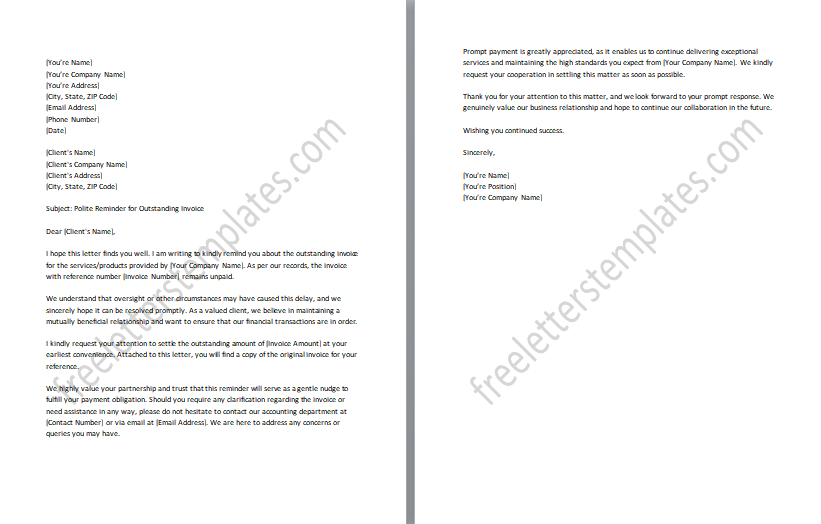
#2: Gentle Follow-up Letter for Unpaid Invoice
The “Gentle Follow-up Letter for Unpaid Invoice” is a communication that seeks to follow up on an unpaid invoice in a tactful and considerate manner. Its purpose is to remind the recipient about the outstanding payment while maintaining a friendly tone. This type of letter is typically used when a previous invoice remains unpaid, and a gentle nudge is needed to prompt the recipient to fulfill their financial obligation. The letter aims to balance assertiveness with professionalism, encouraging prompt payment while preserving a positive business relationship.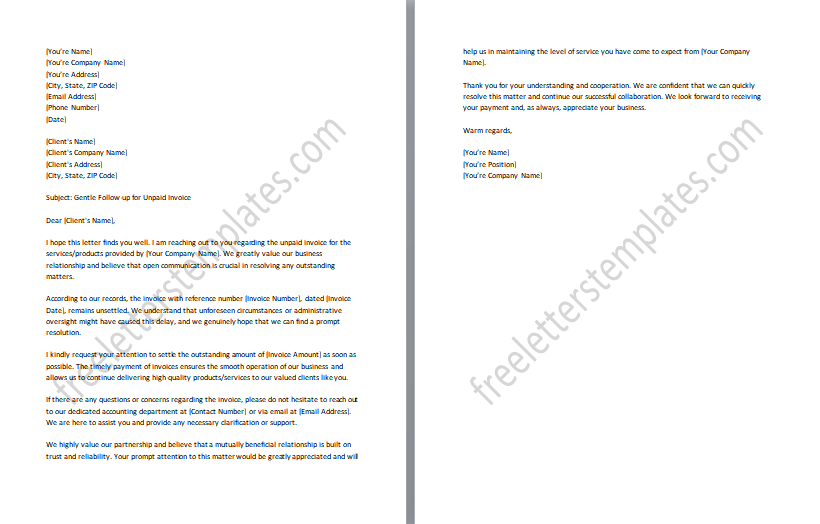
#3: Second Notice Regarding Unsettled Invoice
The “Second Notice Regarding Unsettled Invoice” is a letter sent to remind the recipient about an outstanding invoice that remains unpaid even after a previous reminder. Its purpose is to provide a stronger message regarding the unsettled payment while maintaining a professional tone. This type of letter is typically used when initial reminders have been disregarded, and a more assertive approach is necessary to prompt the recipient to take action. The letter emphasizes the importance of settling the invoice promptly and may include additional consequences if the payment continues to be neglected. Its goal is to encourage prompt payment while expressing the urgency and seriousness of the situation.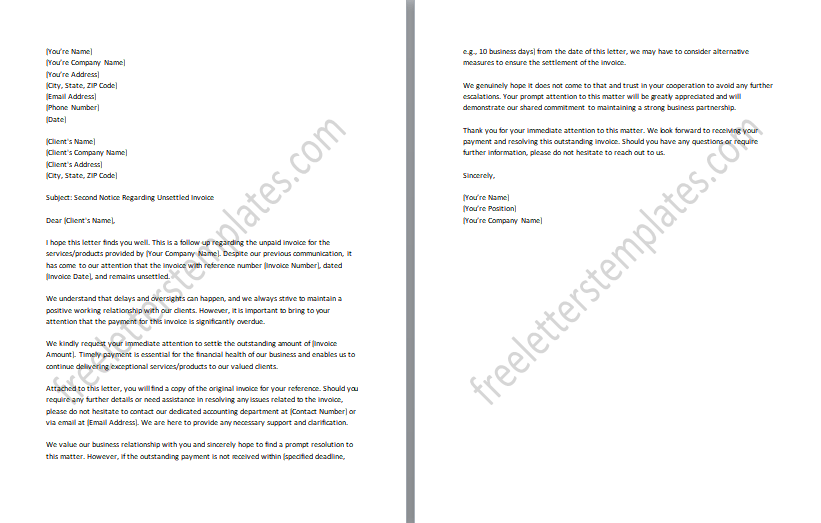
#4: Request for Payment of Overdue Invoice
The “Request for Payment of Overdue Invoice” is a formal letter that seeks to obtain payment for an overdue invoice. Its purpose is to clearly and assertively request the recipient to fulfill their payment obligations. This type of letter is typically used when an invoice remains unpaid past its due date, and a direct request for payment is required. The letter includes specific details such as the invoice number, amount, and due date, emphasizing the urgency of the situation. It aims to convey a professional tone while communicating the expectation for the recipient to remit the overdue payment promptly.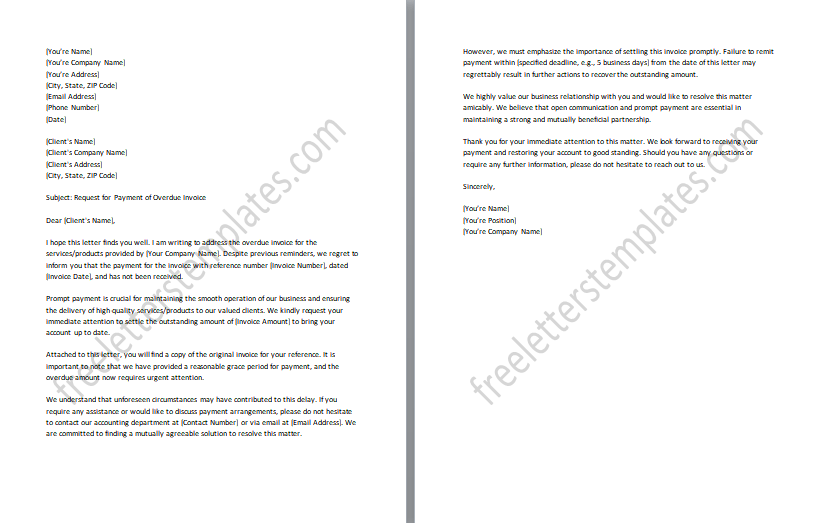
#5: Final Notice for Unpaid Invoice
The “Final Notice for Unpaid Invoice” is a formal letter that serves as a last communication regarding an unpaid invoice before taking further action. Its purpose is to notify the recipient that the invoice remains outstanding despite previous attempts to resolve the matter. This type of letter is typically used when all previous reminders and requests for payment have been disregarded or ignored. The letter clearly states that it is the final notice and emphasizes the urgency and consequences of non-payment. It may include additional measures that will be taken if the payment is not received promptly, such as legal action or engaging a collection agency. The tone of the letter is firm and professional, conveying the seriousness of the situation while encouraging immediate payment to avoid further escalation.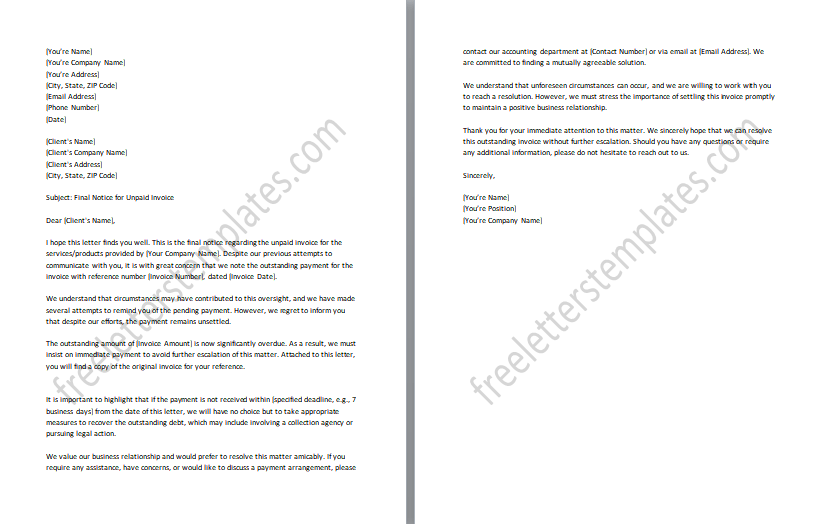
#6: Urgent Follow-up Letter for Outstanding Invoice
The “Urgent Follow-up Letter for Outstanding Invoice” is a letter sent to urgently address an unpaid invoice. Its purpose is to convey a sense of urgency to the recipient, emphasizing the immediate need for payment. This type of letter is typically used when time is of the essence, and prompt resolution of the unpaid invoice is crucial. The letter communicates the outstanding amount, due date, and consequences of non-payment. It aims to expedite the payment process by urging the recipient to take immediate action. The tone of the letter is assertive yet professional, highlighting the urgency while maintaining a respectful approach.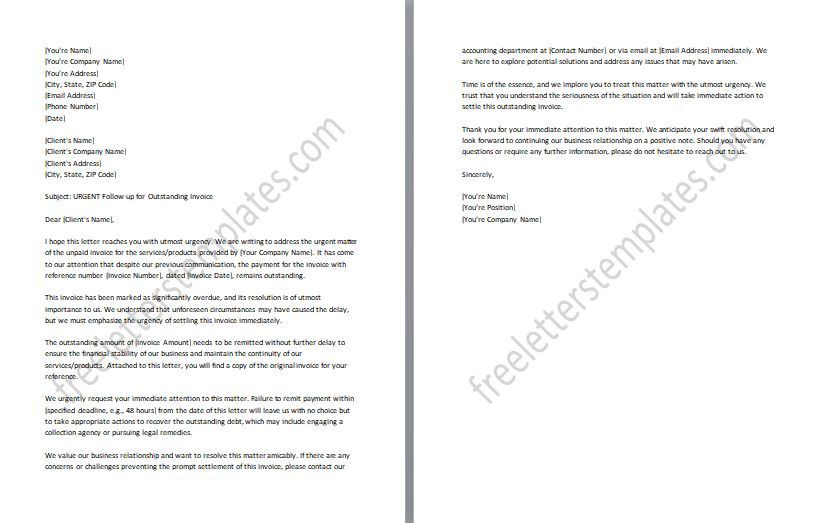
#7: Delinquent Account Reminder for Unsettled Invoice
The “Delinquent Account Reminder for Unsettled Invoice” is a letter sent to remind the recipient about their delinquent account and the unsettled invoice associated with it. Its purpose is to highlight the overdue status of the account and prompt the recipient to resolve the outstanding payment. This type of letter is typically used when an account has fallen behind on payments, and a reminder is necessary to bring attention to the unsettled invoice. The letter may include details such as the invoice number, amount, and due date, as well as any applicable late fees or penalties. Its tone is firm yet professional, emphasizing the urgency of settling the account to avoid further consequences and maintain a positive business relationship.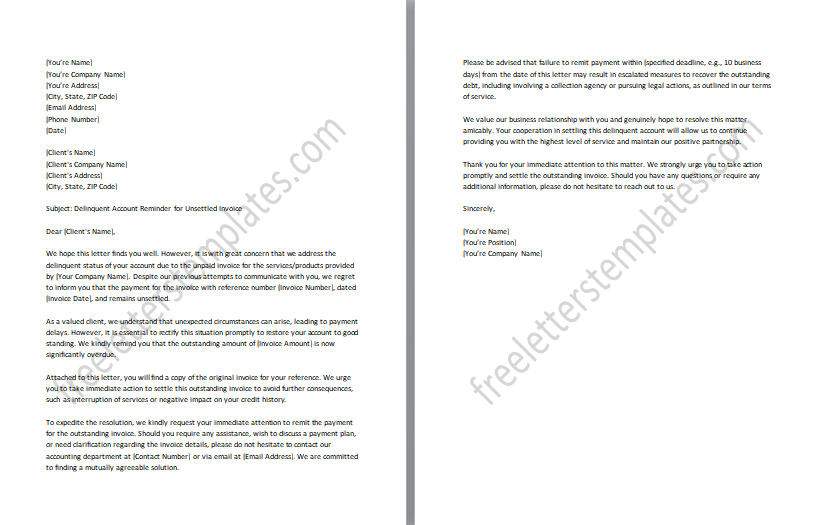
#8: Last Attempt to Collect Payment for Overdue Invoice
The “Last Attempt to Collect Payment for Overdue Invoice” is a final letter sent in a last-ditch effort to collect payment for an overdue invoice. Its purpose is to convey the urgency and finality of the situation, indicating that it is the last attempt to collect the outstanding payment. This type of letter is typically used when all previous attempts to secure payment have been unsuccessful, and more aggressive measures may be necessary. The letter reiterates the details of the unpaid invoice, the amount due, and the extended timeline for payment. It may also mention the potential consequences of continued non-payment, such as legal action or credit reporting. The tone of the letter is assertive, yet professional, conveying the seriousness of the situation while urging immediate action to settle the overdue invoice.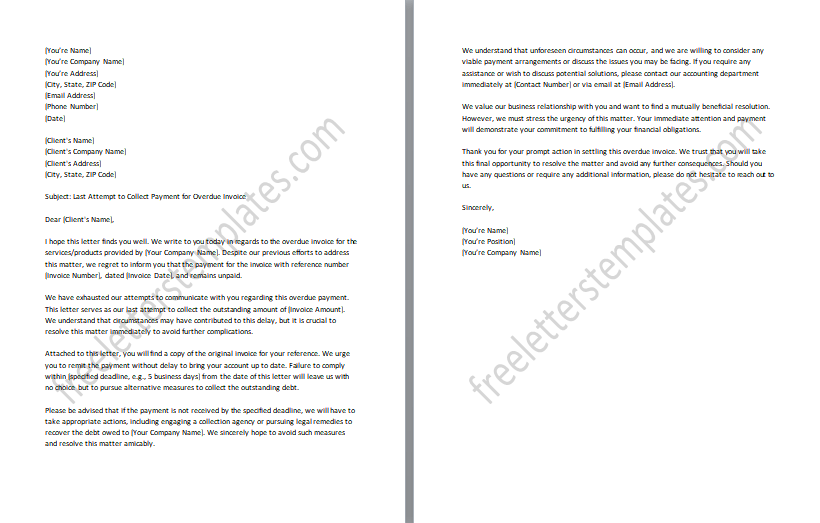
#9: Firm Demand for Payment of Outstanding Invoice
The “Firm Demand for Payment of Outstanding Invoice” is a formal letter that asserts a strong demand for the payment of an outstanding invoice. Its purpose is to communicate the urgency and expectation for the recipient to settle the unpaid invoice promptly. This type of letter is typically used when previous attempts to collect payment have been unsuccessful, and a more assertive approach is necessary. The letter explicitly states the details of the unpaid invoice, including the amount, due date, and any applicable late fees or penalties. It may also emphasize the potential consequences of continued non-payment, such as legal action or credit reporting. The tone of the letter is firm and direct, aiming to convey the seriousness of the situation and compel the recipient to take immediate action in fulfilling their payment obligations.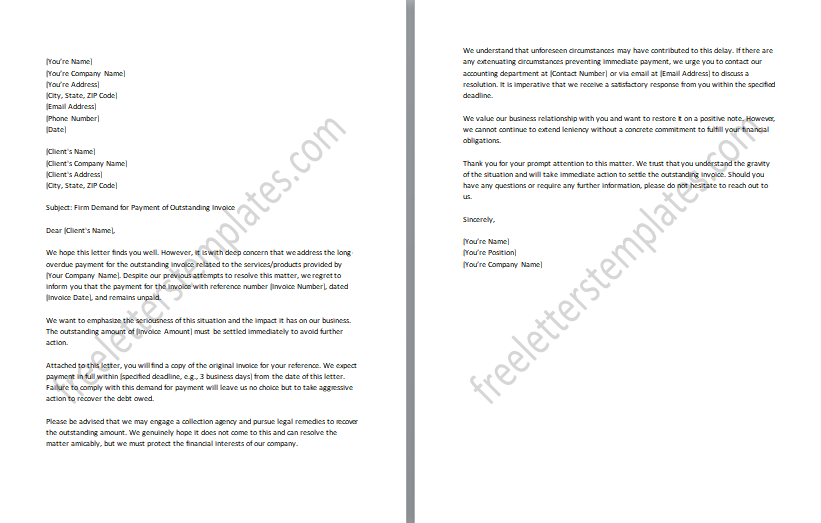
#10: Follow-up Letter for Long Overdue Invoice
The “Follow-up Letter for Long Overdue Invoice” is a letter sent to address a significantly overdue invoice that has not been resolved despite previous reminders. Its purpose is to emphasize the extended delay in payment and urge the recipient to promptly settle the outstanding invoice. The letter restates the details of the invoice, including the amount, due date, and any relevant late fees or penalties. It may also emphasize the impact of the prolonged non-payment on the business relationship and express the expectation for immediate resolution. The tone of the letter is assertive yet professional, aiming to convey the urgency of the situation and prompt the recipient to take immediate action in settling the long overdue invoice.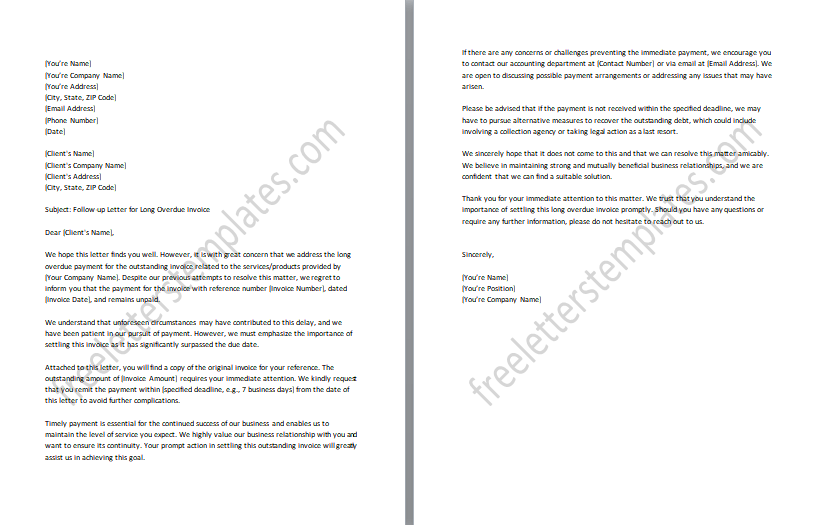
#11: Notice of Legal Action for Unpaid Invoice
The “Notice of Legal Action for Unpaid Invoice” is a formal letter that notifies the recipient of the intention to take legal action to recover an unpaid invoice. Its purpose is to inform the recipient about the serious consequences of continued non-payment and provide a final opportunity to settle the outstanding amount before legal measures are pursued. This type of letter is typically used when all previous attempts to collect payment have been unsuccessful, and other avenues have been exhausted. The letter communicates the details of the unpaid invoice, the amount owed, and the extended timeline for payment. It also highlights the potential legal consequences, such as filing a lawsuit, obtaining a judgment, or engaging a collection agency.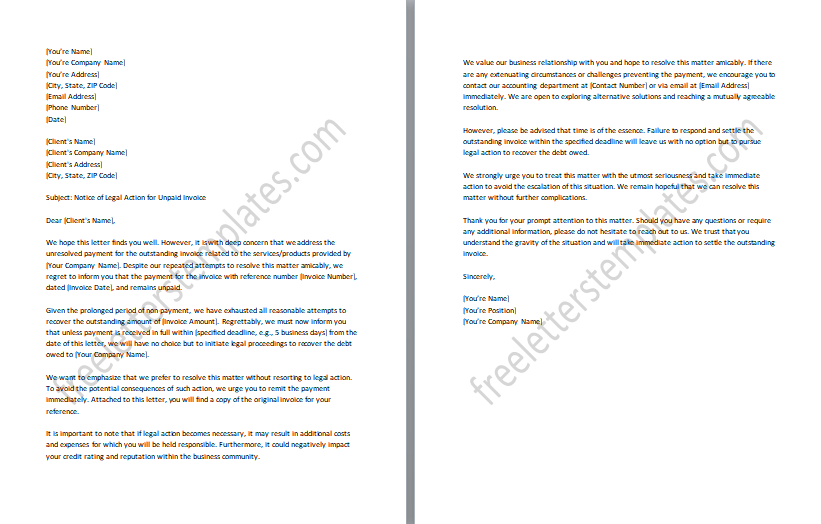
#12: Friendly Reminder to Settle the Outstanding Invoice
The “Friendly Reminder to Settle Outstanding Invoice” is a letter that serves as a gentle and amicable reminder to the recipient about an unpaid invoice. Its purpose is to maintain a positive and cooperative tone while kindly bringing attention to the outstanding payment. This type of letter is typically used when a previous invoice remains unpaid, and a friendly reminder is needed to prompt the recipient to take action. The letter aims to preserve the business relationship by conveying a sense of understanding and offering assistance if needed. It emphasizes the importance of timely payment while maintaining a courteous and helpful tone throughout the communication.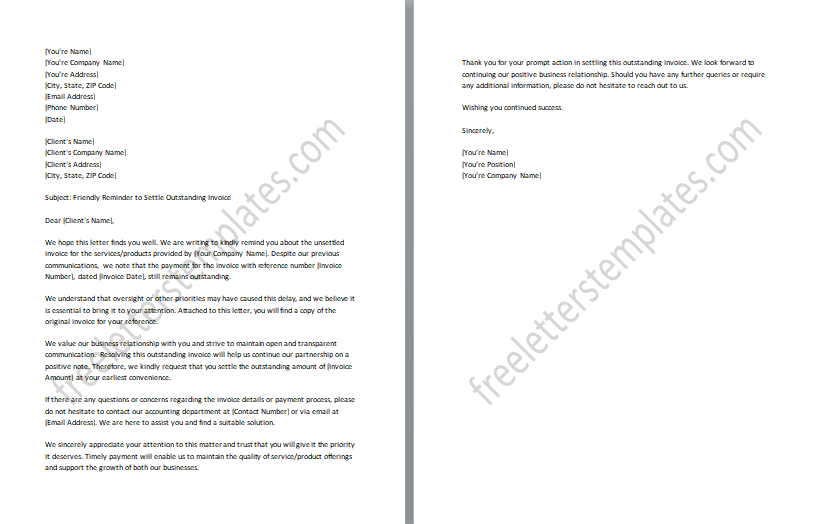
#13: Formal Request for Payment of Overdue Invoice
The “Formal Request for Payment of Overdue Invoice” is a professional letter that formally requests the recipient to make payment for an overdue invoice. Its purpose is to clearly and respectfully communicate the expectation for the recipient to settle the outstanding payment. It maintains a professional and assertive tone, emphasizing the urgency of the situation and the importance of fulfilling the payment obligation promptly. The letter also offers assistance or clarification if needed, encouraging open communication to resolve any concerns or issues related to the payment.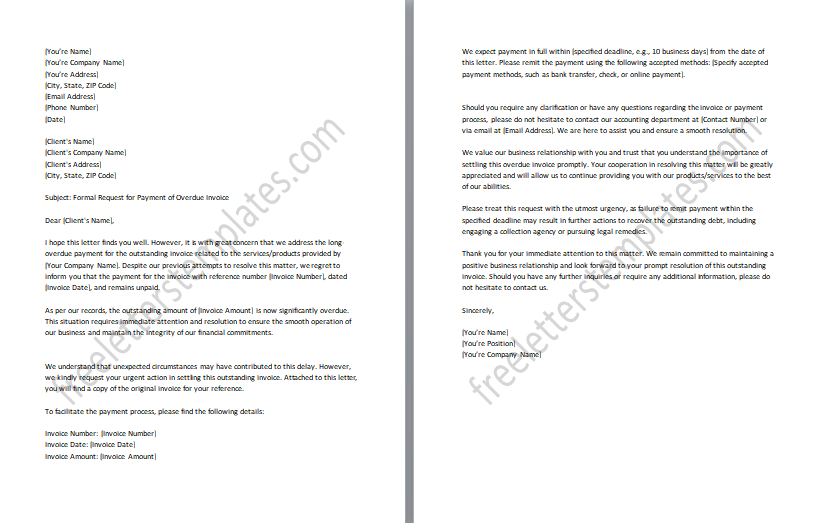
#14: Second Reminder for Unpaid Invoice
The “Second Reminder for Unpaid Invoice” is a follow-up letter sent as a second reminder to the recipient regarding an unpaid invoice. Its purpose is to reiterate the outstanding payment and prompt the recipient to settle the invoice. This type of letter is typically used when the initial reminder did not yield the desired response or payment, and a subsequent reminder is necessary. The letter restates the details of the unpaid invoice, including the amount, due date, and any applicable late fees or penalties. It may also include a summary of previous communications and emphasize the urgency of settling the invoice promptly. The tone of the letter is professional and assertive, reminding the recipient of their financial obligation while maintaining a respectful approach.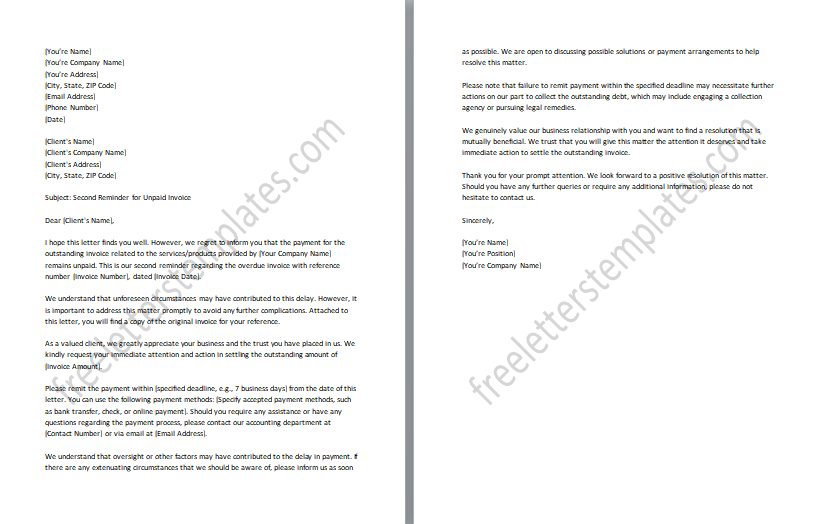
#15: Escalation Letter for Unsettled Invoice
The “Escalation Letter for Unsettled Invoice” is a formal letter sent to escalate the matter of an unsettled invoice to a higher level of authority within the recipient’s organization. Its purpose is to bring attention to the prolonged non-payment and seek resolution through increased involvement from senior or management personnel. The letter communicates the details of the unsettled invoice, the amount due, and any relevant late fees or penalties. It may also mention the potential consequences of continued non-payment, such as the involvement of legal or higher-level authorities. The tone of the letter is firm and assertive, emphasizing the urgency of the situation and the need for immediate action to resolve the unsettled invoice.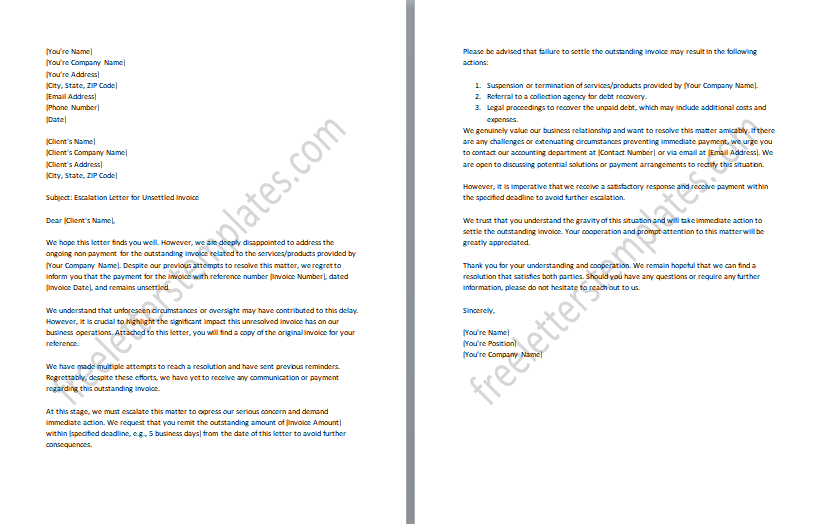
#16: Final Demand for Payment of Outstanding Invoice
The “Final Demand for Payment of Outstanding Invoice” is a formal letter that serves as the last communication demanding payment for an outstanding invoice. Its purpose is to clearly express the urgency and finality of the situation, indicating that it is the last opportunity for the recipient to settle the payment before further action is taken. The letter reiterates the details of the unpaid invoice, including the amount, due date, and any applicable late fees or penalties. It explicitly states that it is the final demand and emphasizes the potential consequences of continued non-payment, such as legal action, credit reporting, or the involvement of collection agencies.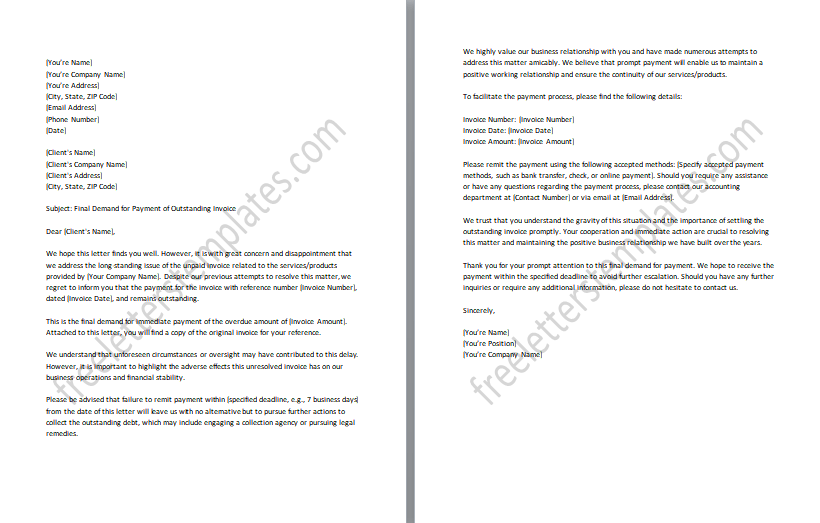
#17: Gentle Nudge to Clear Long Overdue Invoice
The “Gentle Nudge to Clear Long Overdue Invoice” is a letter sent to gently remind the recipient about a long overdue invoice and encourage them to settle the outstanding payment. Its purpose is to provide a friendly and understanding reminder while emphasizing the importance of addressing the overdue invoice. The letter expresses empathy and understanding, acknowledging any potential challenges the recipient may have faced. It restates the details of the overdue invoice, including the amount, the original due date, and any applicable late fees or penalties. The tone of the letter is friendly and supportive, aiming to maintain a positive relationship while encouraging the recipient to clear the long overdue invoice promptly.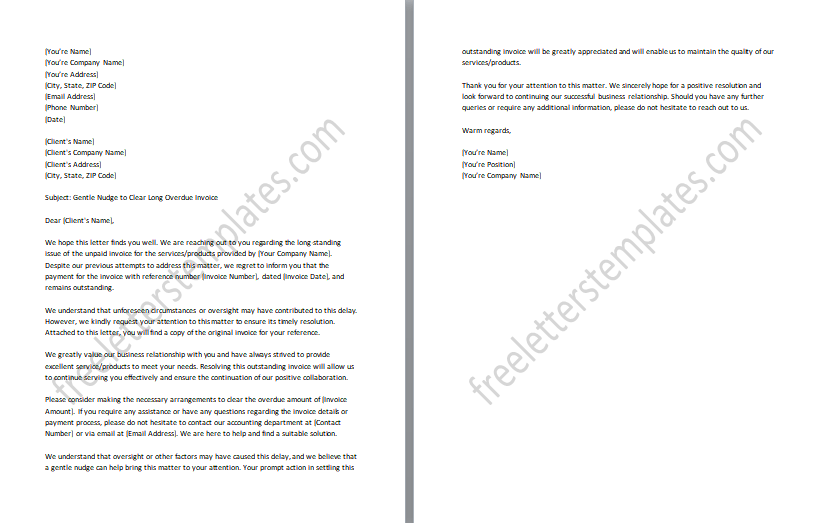
#18: Warning Letter for Non-Payment of Invoice
The “Warning Letter for Non-Payment of Invoice” is a formal letter sent to alert the recipient about the consequences of continued non-payment of an invoice. This type of letter is typically used when all previous attempts to collect payment have been unsuccessful, and stronger measures need to be conveyed. The letter clearly states the details of the unpaid invoice, including the amount, due date, and any applicable late fees or penalties. It emphasizes the impact of non-payment on the business relationship and warns of potential consequences, such as legal action, credit reporting, or the involvement of collection agencies.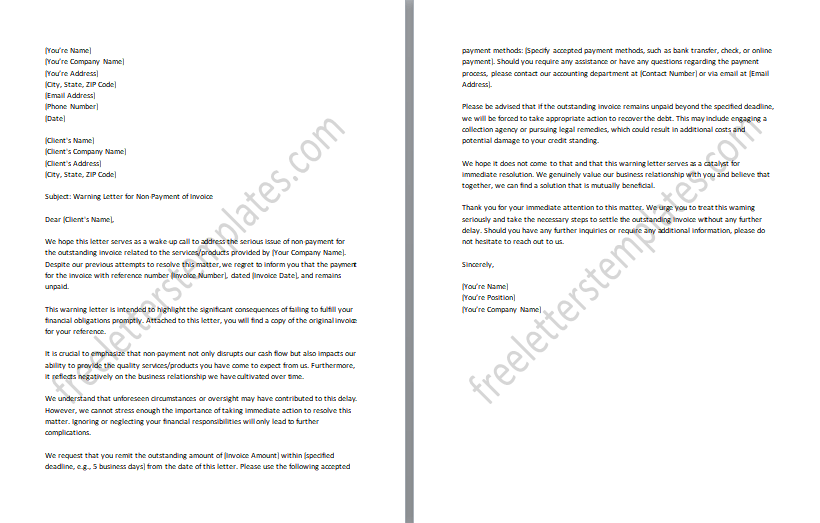
#19: Serious Action Required for Unpaid Invoice
The “Serious Action Required for Unpaid Invoice” is a letter sent to notify the recipient about the necessity of taking immediate and significant action to address an unpaid invoice. The letter clearly states the details of the unpaid invoice, including the amount, due date, and any applicable late fees or penalties. It explicitly emphasizes the potential severe actions that may be taken, such as legal proceedings, damage to the recipient’s credit, or other serious repercussions. The tone of the letter is serious and direct, conveying the gravity of the situation and the absolute need for immediate attention to the unpaid invoice.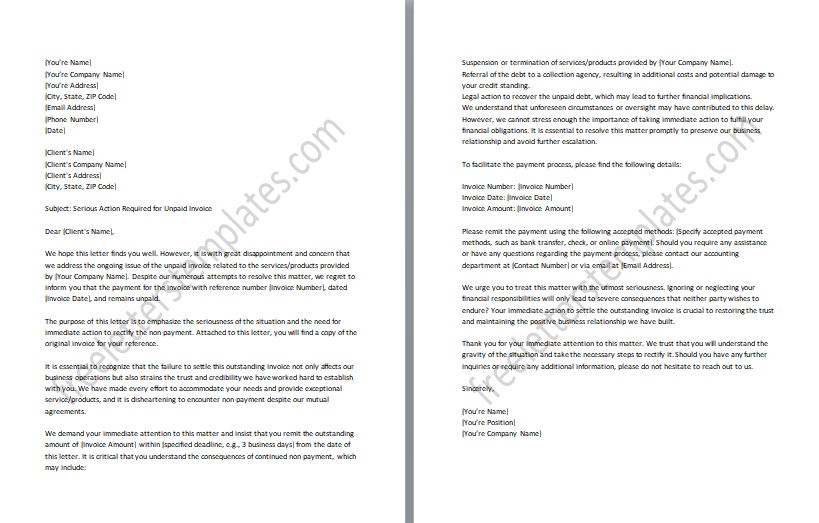
Handling common client objections
When following up on outstanding invoices, it’s important to anticipate and address common client objections or reasons for delayed payments. By doing so, businesses can navigate these challenges more effectively. Here’s a paragraph explaining how to handle common client objections:
One common objection is financial hardship or cash flow issues on the client’s end. Businesses can suggest flexible payment arrangements or installment plans to accommodate the client’s current financial situation. Offering alternative payment options, such as partial payments or extended payment terms, can help bridge the gap and facilitate payment. Additionally, businesses can emphasize the value or benefits the client received from the products or services provided, reinforcing the importance of settling the outstanding invoice. By demonstrating empathy, offering flexible solutions, and highlighting the value received, businesses can overcome objections related to financial constraints and work towards finding mutually agreeable solutions.
Personalization and customization suggestions
When it comes to follow-up letters for outstanding invoices, personalization, and customization can significantly enhance their effectiveness. Here are some suggestions to guide visitors on tailoring their follow-up letters to suit their business and client relationships:
- Reference invoice specifics: Begin the letter by referencing specific details of the unpaid invoice, such as the invoice number, date, and amount owed. This helps to demonstrate that the letter is specific to the recipient and their outstanding payment.
- Address the client by name: Use the recipient’s name in the salutation to create a personalized touch. This shows that the letter is specifically intended for them and adds a sense of importance to the communication.
- Acknowledge the client’s history: If the client has been a long-standing customer or has previously made timely payments, acknowledge their positive history in the letter. This can help maintain a positive tone and reinforce the expectation for prompt payment.
- Consider client preferences: Take into account any known preferences or communication preferences of the client. For example, if they prefer email communication, ensure the follow-up letter is sent via email. Adapting to their preferred method of communication can improve the chances of a response.
- Offer flexible payment options: If appropriate, provide options for payment methods or suggest alternative payment arrangements. This demonstrates a willingness to work with the client and can help facilitate the payment process.
- Tailor the tone: Adjust the tone of the letter to suit the client relationship. For long-standing and valued clients, a more friendly and understanding tone may be appropriate. For newer or more challenging clients, a firm but professional tone may be necessary.
- Provide contact information: Include your contact information, such as a phone number or email address, to encourage direct communication and address any questions or concerns the client may have. This availability reinforces a sense of personalized attention and support.
Proactive invoice management strategies
Proactive invoice management is crucial for preventing overdue invoices and ensuring timely payments. Here are some strategies you can suggest to visitors for effectively managing their invoices:
- Clear payment terms: Encourage visitors to establish clear payment terms upfront with their clients. This includes specifying the due date, accepted payment methods, and any applicable late payment penalties or discounts for early payment. Clear and transparent payment terms help set expectations and minimize confusion or disputes.
- Convenient payment methods: Advise visitors to offer a variety of convenient payment methods to their clients, such as online payment gateways, bank transfers, or credit card payments. Providing multiple options makes it easier for clients to make timely payments using their preferred method.
- Automated reminders: Suggest implementing automated reminders for upcoming or overdue invoices. Automated systems can send friendly reminders to clients a few days before the payment due date and continue with follow-up reminders for any overdue invoices. These reminders can be sent via email, SMS, or through accounting software, ensuring consistent and timely communication.
- Recurring billing systems: Recommend using recurring billing systems for clients with regular or recurring payments. This allows businesses to automatically generate and send invoices on a predetermined schedule, minimizing the chance of missed or delayed payments.
- Early payment incentives: Encourage visitors to consider offering incentives for early payment, such as a small discount or additional service. This can motivate clients to prioritize and settle their invoices promptly, improving cash flow for the business.
- Regular invoice reviews: Emphasize the importance of reviewing invoices regularly to identify any discrepancies or issues promptly. By conducting regular reviews, businesses can catch and address potential payment problems before they become overdue invoices.
- Clear communication channels: Advise visitors to maintain open lines of communication with their clients regarding invoicing and payment matters. Encourage them to provide contact information and encourage clients to reach out with any questions or concerns. This proactive approach promotes transparency and resolves potential issues before they escalate.
Concluding Thoughts
In conclusion, effective follow-up letters for outstanding invoices are essential for maintaining a healthy cash flow and fostering positive client relationships. By implementing personalized and customized strategies, businesses can enhance the effectiveness of their follow-up letters, improving the chances of prompt payment and resolving any payment issues or disputes in a professional manner. It is also important to stay proactive in invoice management by setting clear payment terms, offering convenient payment methods, utilizing automated reminders, and implementing recurring billing systems. By taking a proactive approach and addressing common client objections with empathy and flexibility, businesses can navigate the challenges associated with overdue invoices and ensure the financial stability and success of their operations.